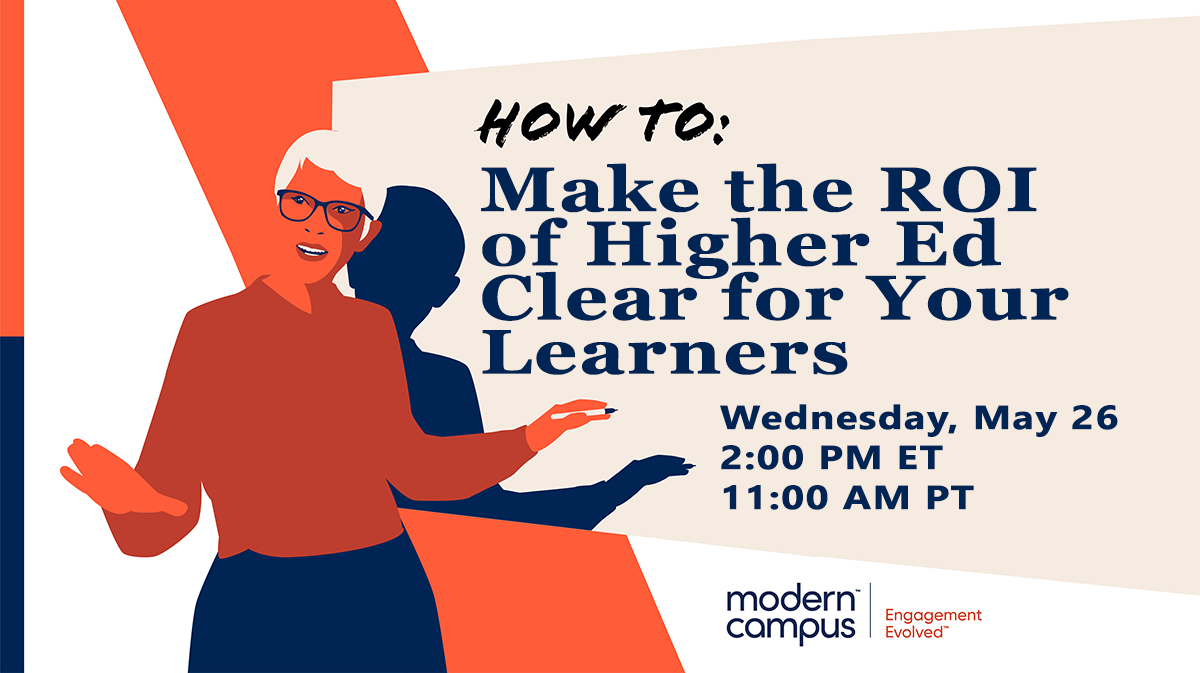Published on
Improving Retention Rates with Career Pathways

Seeing a return on investment is exactly what students want before committing to a course or program at any institution. They need to know that their credentials will get them a job or keep them on their career path. It’s important for students to have insight into the job outcome their education provides, and career pathways are the solution. For institutions to have job market data, it’s critical to have a system that automatically updates you to be efficient with staff’s time. In this interview, Chris Young discusses how to implement career pathways, drive student enrollment and create lifelong engagement with your students.
The EvoLLLution (Evo): Why is it valuable for students to have visibility into career pathways and into the direction that a particular course or program might send them?
Chris Young (CY): If you think about sales or marketing, you’re thinking about features and benefits. Yet when we talk about programs prospective students could enter, there’s sometimes a disconnect between the program itself and what that translates to in terms of job opportunities. There may be similar degrees that could result in higher pay or more jobs available for one degree than another. This is the benefits side of the equation.
But it’s been difficult to work that information into the equation. A lot of effort is needed to do that research, take the data and put it into a clean format to give to the prospective student. That is added to all of our other job responsibilities. Then we have to keep it all up to date. The challenge: limited time and money to make that happen. So this is something that’s been on our minds but prior to Pathways, we haven’t seen a clear solution that addresses the associated challenges.
Evo: How much time or effort would go into sharing broad labor market opportunity data for students considering a particular course or program?
CY: Say I wanted to track and implement several metrics across our programs. Just doing the research on one metric to apply across several hundred programs will take time. By the time we’ve collected all of that data, it’s likely already outdated. Wrong or outdated information is worse than no information. To gather this kind of data manually just would not be practical.
Evo: What are the characteristics of a great digital experience or website when it comes to engaging students and driving enrollment?
CY: In any space, you have to start with the consumer’s mindset. A challenge we have in higher ed is having so many structures within the university setting. Whether it’s on the academic or administrative side, or in student services. We know how those are administered, and which office is responsible for which set of services. But students don’t care about that—they just need to know what services are there to assist them, and how to connect to them. So, one of the challenges for us is to spin this education delivery model around. To stop thinking about how we structurally deliver and start thinking about how students consume.
It also applies to the academic side. We’re delivering something to our students. We have to think about what they’re going to do with it and why they want it in the first place. The Modern Campus Pathways solution considers the student’s pain point. What does the student (the consumer) want? A satisfying career.
You start with making that connection between education and career before they’ve ever even arrived. The relationship kicks off by us showing the student that it’s not just about what we’re going to teach them, but by helping them see what they’re going to take away from their experience.
An 18-year-old choosing between different institutions will not necessarily look at a program and immediately understand the career paths the program opens up. They’re possibly looking at dozens of institutions and trying to find one that fits.
If the website, the center of the university’s marketing efforts, can’t clearly identify the benefits associated with a given course or program, will the prospective student value that program as highly as the next website down the way that clearly ties all those pieces together for them and tells a story?
Evo: Why is it important for higher education institutions to find ways to make marketing groups more a part of their strategic decision-making processes?
CY: Unless you want to be a doctor or lawyer—something that requires a specific degree—you might not end up in the career you envisioned after graduation. Regardless, during your time in college, you are learning to learn. Learning enables you to adapt, so now you are a flexible worker. In 30 years, when the next disruptive change comes about, you’ll be able to adapt and learn new skills to keep a job.
Most marketing efforts are driven to a website. Done properly, this will get the right information into the right hands at the right time. It’ll be done for us. Everything’s being driven to the website in the first place. So it’s important that the website doesn’t approach those strategic decisions in a totally reactionary manner.
Evo: How can something like the Pathways module support a more engaging value proposition for lifetime engagement between a student and the institution?
CY: You start with making that connection before they’ve ever even arrived. It says, “Look, it’s not just about us. It’s about you. It’s not just about what we’re going to teach you. It’s about what you are going to take away from this.” We want to be able to show them what their career path will look like. That should make for a cleaner path for them through their higher education experience. Maybe they’ll make better course choices, ones that are aligned with their end goal at graduation. So, we’ve made it smoother there. We’ve shown them the path through potential career progression. We want to show them that we’re not just concerned for them as a student, but as a successful person throughout their career.
When it comes to job boards, we want to continue to assist the students. We want to connect them to the handful of employers that hire students through us. There could be great opportunities, but they’re necessarily known to the institution except through these job boards.
Evo: How do you assess the success of a tool like Pathways?
CY: With today’s technology, digital tools have given us some opportunities to dig down and look for places where divergent things converge. We may find that the percentage of students coming into a program and graduating is increasing. This could be because they have an understanding of the career they’re going through.
Evo: How important is it to be very open about features and benefits when it comes to attracting prospective students?
CY: Until you recognize the value that something offers you, it means little. You have to make a logical leap from features to benefits, and you may not do that on your own. When a college or university shows a prospective student not only their programs but also the career path opportunities provided by those programs, it moves from talking about features to talking about benefits. In evaluating their options, those universities that focused on benefits will stand out from the pack.
This interview was edited for length and clarity.
Disclaimer: Embedded links in articles don’t represent author endorsement, but aim to provide readers with additional context and service.
Author Perspective: Administrator




